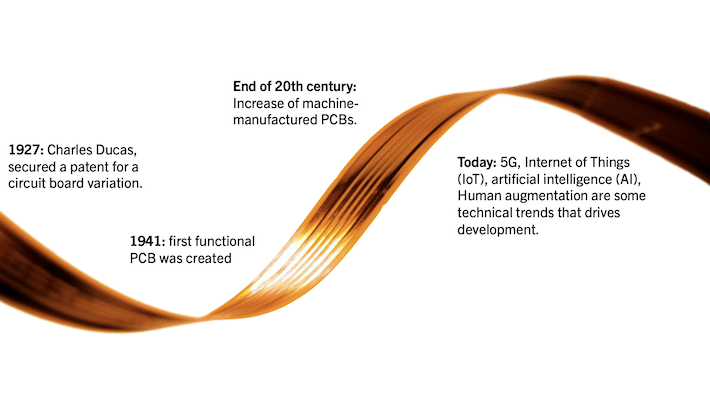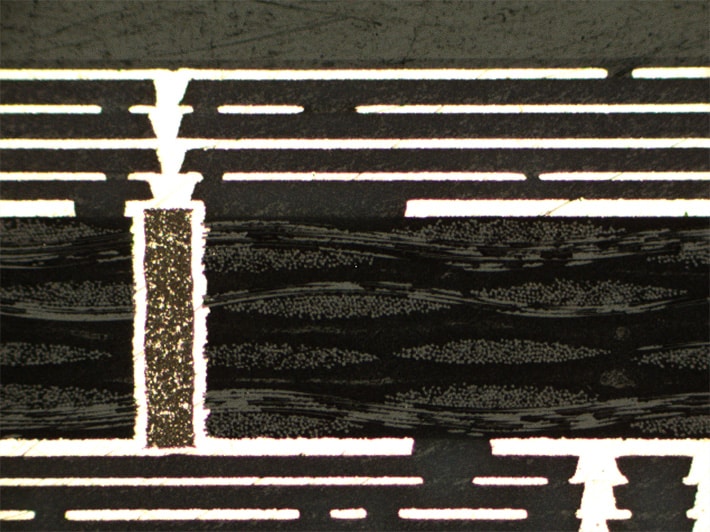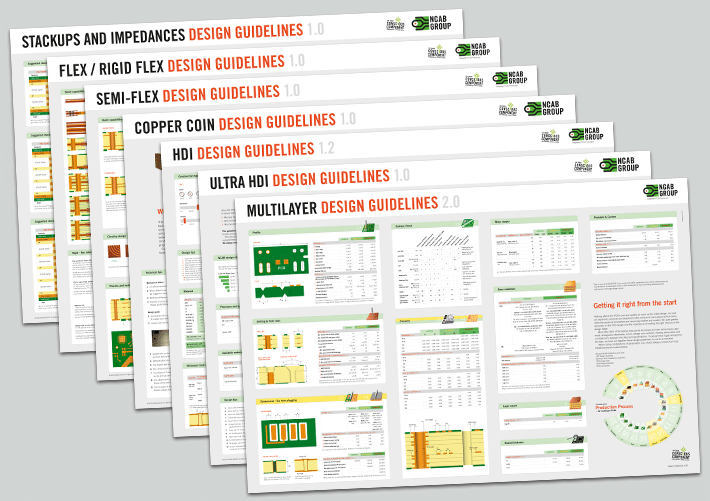At the heart of all electronics, we have printed circuit boards (PCBs) – an integral part in modern electronics as they play a vital role in technological innovation and advancement across various industries. From its early developments to the modern and sophisticated PCBs which we see today, it’s important to share the history of PCBs in order to understand its value, and how much it has evolved throughout time.

Early developments
Before we had the PCBs that we know and love today, electronic circuits were being wired on a chassis – a sheet metal frame or pan where components were attached to it by insulators.
The circuits were large, heavy, bulky, and fragile, and on top of its makeup, the products were expensive to produce and were labour intensive. In the early 20th century, engineers started to experiment with creating more efficient and compact circuits, which led to the development of the methods used in modern PCBs.
History of PCBs – Early Concepts: Albert Hanson and Charles Ducas, and the impact of the stock market crash
In 1903, a German inventor by the name of Albert Hanson, contributed to the development of PCBs through his work with early breadboards, which were arguably the precursors to modern PCBs.
Albert’s pioneering work in PCB technology was instrumental in the development of modern printed circuit boards. He introduced through-hole construction with conductors on both sides, resembling the plated through-hole PCBs utilized today. His innovative efforts involved creating prototype circuits that featured conductive tracks on insulating boards, laying foundational groundwork for later advancements in PCB technology.
In 1927, Charles Ducas, a French innovator, secured a patent for a circuit board variation. Employing a stencil, he imprinted wires onto an insulated surface using conductive ink, effectively establishing an electronic pathway. His creation, known as printed wiring, served as an early iteration leading to the development of today’s electroplating techniques. Sadly, the continued innovation of PCBs would come to a halt due to the stock market crash in 1929 and the Great Depression. An understandable shift in people’s prioritization and needs.
Paul Eisler and the impact of war
It wasn’t until the attack on Pearl Harbor during World War II that significant attention returned to the adaptation and advancement of PCB-like technology – thus continuing the history of PCBs. In the 1940s, a significant leap in PCB development emerged through the work of Austrian engineer Paul Eisler, credited with creating the first functional PCB around 1941.
Eisler’s innovation involved utilizing a copper foil layer adhered to an insulating board, establishing conductive pathways for electronic components. By 1943, he introduced a radio equipped with a PCB, which would later prove instrumental in military operations. Following World War II, PCBs garnered increased interest due to rising demands for smaller, lighter, and more dependable electronic devices. Their commercial potential became apparent, leading to their swift integration across various electronic applications.
Advancements and Integration
Throughout the latter part of the 20th century, advancements in manufacturing processes, including etching and soldering techniques, ushered in greater complexity and miniaturization within PCBs. This progress proved pivotal as global attention, particularly in the US, shifted toward space exploration. Weight and energy efficiency were critical concerns for spacecraft, and the lightweight and energy-efficient nature of PCBs made space exploration more feasible.

The advent of the digital age saw an explosion of gadgets such as gaming consoles, VHS recorders, computers, and compact disc players. This era marked an immense technological boom, with electronics becoming ubiquitous in daily life. As devices continued to shrink in size (reflecting the trend of miniaturization), manual PCB manufacturing became increasingly intricate, leading to a surge in demand for machine-manufactured PCBs.
With a shift toward dedicated manufacturing processes, the significance of PCB designs intensified. Soldering or rewiring boards with smaller components became a more intricate task, emphasizing the critical role of precise PCB designs in accommodating these evolving technologies.
Modern history of PCBs – a changing world
Today’s PCBs showcase immense sophistication, integrating multilayer boards, surface mount components, and computer-aided design (CAD) to facilitate intricate circuitry. However, it’s not solely about these specific technologies that propel the current PCB landscape forward. Rather, it’s the evolving technology trends and their related applications that drive and augment the potential of PCBs.
So, what are these technology trends influencing the world of PCBs? They can be categorized into two main segments: 'people-centric’ trends, which focus on how technology impacts us, and 'smart spaces’ trends, which concentrate on technical advancements affecting living or working environments. Some key technical trends driving development include 5G, Internet of Things (IoT), artificial intelligence (AI), Human augmentation, hyper-automation, and autonomous things. These trends enable the transmission, transfer, management, and processing of substantial data volumes in short time frames, minimizing latency issues – a crucial aspect of edge computing.

In conjunction with these trends, PCB manufacturing is expected to advance, encompassing areas such as the development of multilayer boards with increasing layers, flexible and flex-rigid boards, intricate HDI structures utilizing IC substrates for minute track and gap sizes as small as 20-30 μm, diminutive via holes, direct imaging methods directly printing the pattern on the material, enhanced automation in manufacturing processes, and the introduction of new surface finishes – among several other advancements.
As you can see, the history of PCBs is a long one with many influential people, along with growing technology needs, playing a role in its development. As a company that supplies high demanding customers with PCBs, and see’s value in sharing and educating people in the world of PCBs, it is important to understand how the green circuit board came to be, and where it is heading.

PCB design guidelines
Get it right from the start with our PCB design guidelines. To prevent getting it wrong from the start, we have put together our design guidelines, to use as a checklist.
